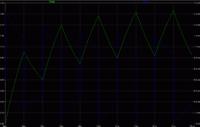perchick
Newbie level 5

hello.
im new here, so hope this is the right place for this type of questions.
its a pretty easy question but i cant seem to get to the answer. lets say i generate 5 volt step function with duty cycle of 50% in an RC circuit and im measuring the voltage on the capacitor. lets say that the frequency is high (T/2<<τ) the capacitor will charge for T/2s and discharge for the rest T/2s. here's my problem: after a while the voltage on the capacitor will stabilize on 2.5V. why is that? the function for charging and discharging is the same, so why is that the capacitor stands on 1/2 of my amplitude after a while? it seems that the capacitor is charging faster then hes discharging?
as i understand for T/2<<τ the function thats describes the voltage on the capacitor is Vc=1/RC*∫Vin*dt so when t-->0 i should get Vc-->0. I have no idea where is my problem. I hope you can explain what im doing wrong
im new here, so hope this is the right place for this type of questions.
its a pretty easy question but i cant seem to get to the answer. lets say i generate 5 volt step function with duty cycle of 50% in an RC circuit and im measuring the voltage on the capacitor. lets say that the frequency is high (T/2<<τ) the capacitor will charge for T/2s and discharge for the rest T/2s. here's my problem: after a while the voltage on the capacitor will stabilize on 2.5V. why is that? the function for charging and discharging is the same, so why is that the capacitor stands on 1/2 of my amplitude after a while? it seems that the capacitor is charging faster then hes discharging?
as i understand for T/2<<τ the function thats describes the voltage on the capacitor is Vc=1/RC*∫Vin*dt so when t-->0 i should get Vc-->0. I have no idea where is my problem. I hope you can explain what im doing wrong





